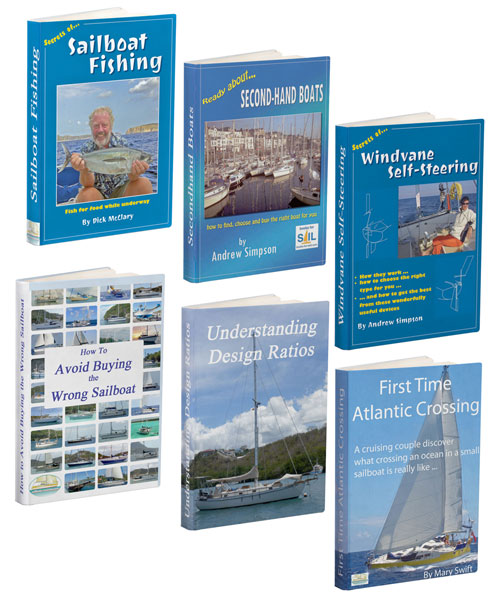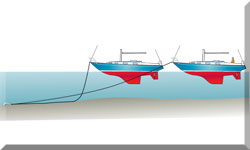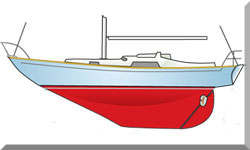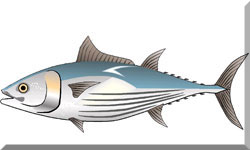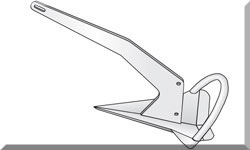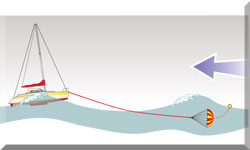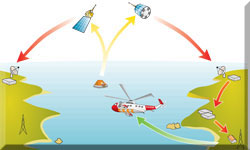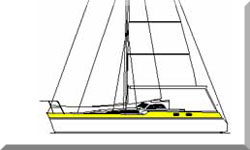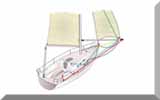- Home
- Offshore Seamanship and Heavy Weather Tactics
- Single Handed Sailing
Single Handed Sailing: The Risks, Rewards & Essential Prep for Solo Passages
In a Nutshell...
Single Handed Sailing is an intensely personal journey that demands a professional level of competence and preparation. The core takeaway for any experienced sailor considering this path is that the vessel needs to become a true extension of the single crew member, with all critical controls centralised and redundancy engineered into every system. Success hinges on a reliable setup (windvane self-steering is key!), meticulous planning, and an iron discipline regarding sleep and safety—you must clip on. It's a demanding pursuit, but the rewards in hard-won self-reliance are simply immeasurable.
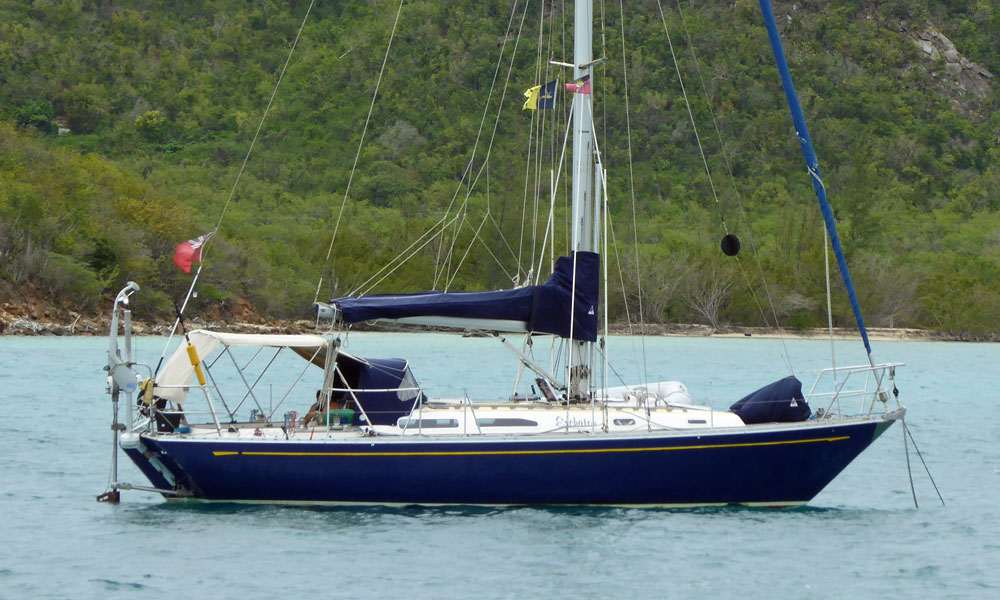 A Rustler 36 set up for single-handed ocean sailing
A Rustler 36 set up for single-handed ocean sailingTable of Contents
- The Call of the Sea: Why Sail Alone?
- The Practicalities: Rigorous Planning for Solo Passages
- The Cost of Going Solo: Planning the Budget
- Preparing the Vessel: Modifications for Safety & Efficiency
- Optimising Sail Trim & Performance Alone
- Redundancy & The Solo Maintenance Mindset
- The Elephant in the Room: Compliance with COLREGS Rule 5
- The Psychological Toll: Managing Solitude & Decision Fatigue
- Communication & Emergency Protocols
- Summing Up
- Frequently Asked Questions (FAQs)
The Call of the Sea: Why Sail Alone?
Ever wondered why some seasoned sailors consciously choose to go it alone, opting for the singular challenge of single handed sailing? For those of us who have spent countless miles offshore, the motivation goes beyond just convenience. There are a great many reasons why this demanding niche holds such a powerful draw.
For starters, it takes a serious level of skill and smarts to handle a boat—especially a sizable yacht—by yourself. That mastery is, in itself, an awesome challenge and a massive confidence booster. Plus, you become the undisputed master of your own destiny out there: you have total freedom to set the course, choose the destination, and decide the pace. No debates over watch schedules, no dragging feet over anchoring spots.
It’s a genuine journey of self-discovery, forging resilience and resourcefulness you simply won't cultivate any other way.
Beyond the personal growth, there are practical realities. Finding a compatible, skilled, and reliable crew isn't always easy (or cheap!). Sailing solo immediately sorts out both those logistical headaches. And for the competitive among us, it’s the only path to achieving high-stakes goals, like participating in iconic solo races or attempting a circumnavigation.
But for me, and I suspect for many others, it’s the magical, almost spiritual, side of being truly alone on the water—a deep, unhurried connection with nature and a chance to truly unplug from the relentless humdrum of modern life.
Of course, this isn't for everyone. It demands serious physical and mental preparation, absolutely solid sailing skills, and an analytical head on your shoulders. But for those who are ready for it, the rewards are incredible.
On the Water...
I got into solo sailing early on. My career, loosely speaking, involved contract work overseas, giving me regular three to four-week leave periods—ample time to make serious miles. That’s how I managed to move my Nicholson 32, Jalingo II, mostly single-handed, from the UK to the Mediterranean over several hops:
Falmouth (UK) >>> Camaret (France) >>> Vigo (Spain) >>> Vilamoura (Portugal) >>> Gibraltar >>> the Balearic Islands, and eventually back to the UK.
It was demanding, but the sheer satisfaction of making those passages alone is unmatched. Of course, once Mary came into my life, those dedicated single-handed days were over!
The Practicalities: Rigorous Planning for Solo Passages
So, you’re seriously contemplating a solo passage? We’re not talking about a quick single-handed day sail along the coast here, but a longer offshore commitment. Your approach to preparation must be professional.
Passage Planning & Shore Support
- Route & Contingency: Map out your intended route meticulously, paying close attention to weather patterns, currents, and tides. A robust passage plan must always include at least one, and preferably two, viable fallback plans for safe harbours or anchorages should things turn sour.
- Shore Contact: Share your full float plan (route, estimated timings, check-in intervals) with a reliable contact ashore. This person is your safety net and must understand exactly when and how to raise the alarm.
Operational Protocols & Fatigue Management
Getting into a solid routine is essential. It usually takes two or three days for your body and mind to reluctantly align with the watch-keeping routine.
- Sleep Management: Implement a strict routine of short, high-quality naps (20-40 minutes) to manage sleep deprivation, which is the single greatest risk to a solo sailor. Don't be heroic.
- Regular Checks: Maintain a log and conduct regular, scheduled checks of all systems: bilge, engine, sails, rig, and navigation equipment. Never skip these.
- The Golden Rule: Always, and I mean always, wear your safety harness and tether when on deck, day or night. Clip on to your jackstay, which must be rigged to provide uninterrupted access along both sides of the boat, from bow to stern.
- Tidiness: A tidy boat is a safe boat. Secure absolutely everything that could move, both below and on deck. This prevents dangerous accidents and ensures critical gear is instantly accessible.
- Self-Care: Stay fit, hydrate religiously, and eat well. Single handed sailing is physically and mentally taxing, so you need to be in top form.
The Cost of Going Solo: Planning the Budget
While you save on crew costs, converting a yacht for true offshore single handed sailing is a significant investment. Expert intent requires acknowledging this reality.
A high-quality, servo-pendulum windvane and professional installation can easily run to $6,000 or more. Similarly, installing reliable power redundancy (solar, alternators, battery banks) and modern AIS/Radar units is expensive. Budgeting for quality equipment like a grab bag, EPIRB, and comprehensive spares is non-negotiable.
Insurance Considerations for Solo Sailing
Factor in the cost of specialist offshore insurance; many UK providers will place strict limits or impose conditions on vessels undertaking long solo passages, reflecting the heightened risk of unmitigated emergencies. For offshore work, you will likely need to:
- Specify Solo Use: Inform your insurer if you intend to sail single-handed offshore; standard policies may limit or exclude cover for longer solo passages.
- Agree Navigation Limits: Discuss and agree upon the territorial limits of your passage. Cover for worldwide or deep-ocean cruising requires specialist underwriting.
- Ensure Third-Party Liability: A minimum of £3 million Third-Party Liability is typically a de-facto requirement for most UK marinas and port authorities, even if not a legal requirement for simply owning a boat.
Preparing the Vessel: Modifications for Safety & Efficiency
Transitioning a boat to be a safe, effective solo platform often involves key modifications. Think simplicity, efficiency, and robustness—everything must be manageable from one central, secure position, usually the cockpit.
| Modification | Benefit for Single Handed Sailing |
|---|---|
| Reliable Self-Steering | An essential piece of kit. Allows the skipper to rest, navigate, or perform boat tasks. A servo-pendulum windvane (my personal preference) is unbeatable for long offshore passages due to its reliability & zero power consumption. |
| Centralised Control Lines | Bringing all running rigging, including halyards, reefing lines, & control lines, back to the cockpit. This allows all sail adjustments to be made from the safety & security of the cockpit. |
| Single-Line Reefing | Simplifies the reefing process significantly, making it much safer & faster to reduce sail area when the wind picks up, all without leaving the cockpit. |
| Self-Tailing Winches | (Ideally 2-speed) They automatically cleat the line, freeing up a hand, dramatically simplifying sail handling, & reducing physical strain. |
| Cockpit Shelter | A sturdy sprayhood & bimini combination provides vital shelter from the elements, reducing fatigue during long passages in challenging weather. |
| Anchor Setup | A self-stowing, electric anchor windlass setup is crucial. It minimises effort & maximises control & convenience during anchoring solo. |
| Jacklines & Tethers | Permanent, robust jacklines rigged on both sides, combined with a quality safety harness & a short tether, are non-negotiable for mobility on deck. |
On the Water...
The One Thing I Wouldn't Be Without? Easy—a windvane self-steering system. Ideally, one of the proven servo-pendulum types. They are tireless, reliable, and fundamentally save you from burning precious power on an electrical autopilot.
Optimising Sail Trim & Performance Alone
Single handed sailing isn't just about survival; it's about efficient passage making. Since you can't be everywhere at once, your sail plan must be stable and easily managed. Over-delivering here means focusing on reducing weather helm and minimising required input.
- Heavier Headsails: On a cutter or ketch, use the storm jib or a smaller, heavier-cut headsail that can be left flying in a wider wind range. This reduces the need for frequent sail changes and the burden of constantly monitoring the rig.
- Centre of Effort (CE) Optimisation: Always adjust the sail plan to keep the centre of effort further forward than you might with a crew. This slightly reduces boat speed but dramatically reduces weather helm, making the autopilot or windvane work much less, saving power and reducing gear strain. Achieving a neutral or slight weather helm is the ultimate goal.
- Reefing Point Discipline: Reef earlier than you think you should. Reefing the mainsail slightly and keeping the boat balanced with a reduced headsail is far more efficient than struggling with a full rig and an overburdened autopilot. Remember, the safest speed is often not the fastest speed, but the most sustainable speed that doesn't demand constant intervention.
Redundancy & The Solo Maintenance Mindset
For the experienced sailor, getting the boat ready isn't just about good maintenance; it's about building redundancy. When you're a thousand miles offshore, every critical system must have a robust backup, and you must possess the ability to fix a wide range of failures yourself.
Engineering for Failure
The fundamental principle of single handed sailing is that if a piece of kit can fail, it will fail, usually at the worst possible moment.
- Steering Redundancy: Your chain needs to be: Primary (Wheel/Tiller), Secondary (Windvane/Autopilot), Tertiary (Emergency Tiller), and Quaternary (a jury-rigged solution like a drogue or a steering oar).
- Power Redundancy: You can't rely on a single power source. Your system must combine engine-driven alternator charging with robust green energy sources (Solar, Wind, Hydro-generator).
- Navigation & Communication: Backups for backups. Your primary chartplotter and DSC-VHF are great, but you need a functional handheld GPS, a reliable paper chart system, and an independently powered satellite communication device.
The Art of Offshore Repair
Being a solo sailor means being an all-in-one mechanic, electrician, rigger, and plumber. A well-stocked spares kit is essential, but it’s worthless without the knowledge to use it.
- Chafe Management: Chafe is a silent killer in single-handed sailing. Implement protective measures on all control lines and routinely inspect the running and standing rigging. This is a good time to review our guide on Sail Care & Maintenance: A Guide to Extending Your Sail's Life.
- Immediate Action: If something breaks, heave-to immediately to assess the damage and effect the repair in a stable environment. Never attempt a repair while under load, stressed, or in poor visibility, unless it is truly an emergency.
The Elephant in the Room: Compliance with COLREGS Rule 5
This is the most critical operational and legal challenge for any solo sailor. Rule 5 of the International Regulations for Preventing Collisions at Sea (COLREGS) demands that every vessel maintains a proper lookout by sight and hearing, as well as by all available means appropriate in the prevailing circumstances. A solo skipper isn't exempt.
Practical Watch Alarm & AIS Optimisation
To truly over-deliver on lookout requirements, you must rely on technology designed to mitigate single-handed fatigue.
- Set AIS and Radar CPA (Closest Point of Approach) alarms to be aggressive—far outside the default settings (e.g., 3 nautical miles and 30 minutes).
- Crucially, invest in a reliable watch alarm system (often called a "dead man's switch" or "nap alarm"). These systems require the sailor to press a button every 10 to 15 minutes, or they automatically trigger a loud alarm. Some advanced systems can be integrated with your chartplotter, or even a wearable device, to ensure you are disturbed before a critical AIS or Radar threat enters the alarm zone, making your rest periods safer and more structured.
The Fatigue Factor: The limitations of a single hander cannot be ignored. We can't maintain a true, 100% proper lookout 24 hours a day. Therefore, the solo sailor must mitigate the risk through superior equipment (AIS/Radar), meticulous planning to avoid high-traffic areas, and being acutely aware of when the body needs rest. This proactive approach to safety is interwoven with broader seamanship skills; you can find more advanced strategies for avoiding and managing high-risk scenarios in our detailed guide on Mastering Offshore Seamanship: Heavy Weather & Safety Protocols. Acknowledge this limitation and constantly strive to minimise the risk of falling asleep while on watch.
The Psychological Toll: Managing Solitude & Decision Fatigue
While the technical challenges are tangible, the greatest test of single handed sailing is psychological. When alone for weeks, your inner state becomes the most critical piece of equipment on board.
Battling Sleep Deprivation & Hallucination
- Impaired Judgement: Prolonged sleep deprivation leads to poor risk assessment—you become slower to reef and prone to poor navigation decisions. You just can't trust your instincts when you're that tired.
- The Voices: Auditory and visual hallucinations are common during extended solo passages. Your brain plays tricks. Recognising this as a symptom of fatigue, rather than a genuine threat, is critical to maintaining control.
- The Recovery Phase: You must build in periods of quality, uninterrupted sleep, even if it means slowing the boat down or anchoring. Sleep debt is real, and it’s dangerous.
Overcoming Loneliness and Maintaining Morale
- Establish Rituals: Create a rigid daily routine for everything outside of sailing: check-in calls, meal preparation, maintenance tasks, and exercise. These rituals anchor you to reality.
- The Morale Diet: Food becomes a massive psychological lever. A pre-planned weekly 'morale meal' can provide a disproportionate boost to your mental state when you need it most. Don't underestimate a good cup of tea and a biscuit either.
- Process and Journaling: Writing a detailed log or keeping a journal is an excellent tool for processing events and maintaining objective clarity. If you can clearly write down a difficult decision, you’ve engaged the rational part of your brain.
Crucial Mental Discipline: A single-handed sailor's mood is the number one safety item. Don't let a small breakdown (a spilled cup of coffee, a jammed line) spiral into a fit of anger or self-pity. Accept the breakdown, fix it calmly, and move on. Your primary job is to be an emotionally stable captain.
 Dr Michael Cohen
Dr Michael CohenWe are fortunate indeed to have Michael Martin Cohen, M.D., a practising neurologist and a keen sailor, as a contributor to this website.
Here's what he has to say about sleep and the single-hander: Solo Sailing and the Need for Sleep...
Communication & Emergency Protocols
Out on a long passage, communication isn’t a convenience—it's a lifeline.
- VHF Radio: An essential for short-range communication and distress signals. Ensure it's a DSC (Digital Selective Calling) enabled unit, properly registered and linked to your GPS.
- Offshore Comms: A satellite communications system (e.g., sat phone, Iridium GO!) is required for reliable weather updates and shore support check-ins.
- Distress Beacons: An EPIRB (Emergency Position Indicating Radio Beacon) and a personal PLB (Personal Locator Beacon) are non-negotiable. Ensure they are correctly registered with up-to-date details.
- MOB Recovery:The Last-Chance Line A single-handed Man Overboard (MOB) recovery system is vital. For the solo sailor, there is a final, desperate tactic: attaching a sturdy, floating line (often weighted slightly) to the self-steering gear (be it a windvane blade or the electronic autopilot's quadrant). If you find yourself in the water and your boat is sailing on without you, grabbing this line and pulling hard might be your only chance. The shock load of the tensioned line will immediately put the helm hard over, forcing the boat to either heave-to or sail into a circle, effectively slowing its escape. This is not a reliable recovery system, but a crude, physical intervention that might just give you a chance of getting back aboard.
Summing Up
The decision to embark on a single handed sailing passage is not one to take lightly. It strips sailing back to its most fundamental elements: you, your boat, and the sea. The ultimate success of the endeavour rests on your mindset, the financial commitment to redundancy, and the discipline to manage your psychological state. If you respect the risks, prepare diligently, and listen to the advice of both your instruments and your instinct, you will unlock a level of sailing satisfaction that remains unmatched by any crewed voyage.
This article was written by Dick McClary, RYA Yachtmaster and author of the RYA publications 'Offshore Sailing' and 'Fishing Afloat', member of The Yachting Journalists Association (YJA), and erstwhile member of the Ocean Cruising Club (OCC).
Frequently Asked Questions (FAQs)
What are the biggest risks associated with single handed sailing?
What are the biggest risks associated with single handed sailing?
The biggest risks are sleep deprivation leading to impaired judgment, the inability to maintain a proper lookout (COLREGS Rule 5), and Man Overboard (MOB) incidents. Mitigation involves a strict short-nap routine, the use of aggressive AIS/Radar alarm settings, and always tethering yourself to the boat while on deck.
Is a windvane or an electronic autopilot better for solo offshore sailing?
Is a windvane or an electronic autopilot better for solo offshore sailing?
For long offshore passages, a windvane self-steering system is superior. It draws no power, is highly reliable, and is often the more robust solution for sustained heavy weather steering. The electronic autopilot is better for motoring and short-term, complex manoeuvres.
How does a single hander comply with COLREGS Rule 5 ('Proper Lookout')?
How does a single hander comply with COLREGS Rule 5 ('Proper Lookout')?
Compliance is achieved by using all available means: maintaining disciplined visual scanning, utilising loud and effective AIS and Radar alarms set with a large CPA margin, and employing a dedicated watch alarm system to ensure periods of rest are as safe as possible.
What is the most critical item to ensure redundancy on board?
What is the most critical item to ensure redundancy on board?
Steering is paramount. You need a multi-tiered redundancy plan for both the main steering (Emergency Tiller) and the self-steering system (e.g., windvane plus robust electronic autopilot). Power redundancy is a close second.
How should I manage the psychological effects of prolonged isolation?
How should I manage the psychological effects of prolonged isolation?
Manage solitude by establishing rigid daily rituals for tasks, using food as a morale booster, and maintaining a detailed log or journal to keep your thoughts clear and rational. Recognise that auditory hallucinations are a sign of severe fatigue.
What is the primary goal of solo sail trim?
What is the primary goal of solo sail trim?
The primary goal is to achieve helm balance (neutral or slight weather helm) by adjusting the centre of effort of the sail plan forward. This reduces the workload on the self-steering gear, saves power, and enables faster, more efficient sailing.
What is the expected cost of converting a yacht for long-distance single handed sailing?
What is the expected cost of converting a yacht for long-distance single handed sailing?
The costs are significant and variable. Converting a yacht to a high safety standard, including a quality windvane, full power redundancy (solar/hydro), and advanced safety electronics, can easily run to a five-figure investment, not including the cost of the vessel itself.
Recent Articles
-
Planning Your Sailboat Liveaboard Lifestyle: An Ocean Sailor's Guide
Dec 06, 25 05:18 AM
Seasoned sailors share their methodical risk analysis for planning a secure Sailboat Liveaboard Lifestyle, covering financial, property, and relationship risks. -
Marine Cabin Heaters: The Expert’s Guide to Comfort & Safety at Sea
Dec 05, 25 06:52 AM
Choose the best Marine Cabin Heaters for your vessel. Expert advice on diesel, paraffin, and hot water systems for year-round cruising comfort. -
Marine Water Heating Systems: Free Hot Water from Your Boat's Engine
Dec 03, 25 05:06 PM
Tap into your engine's heat to get free hot water on board. An experienced ocean sailor's guide to marine water heating systems, calorifiers & safety.
